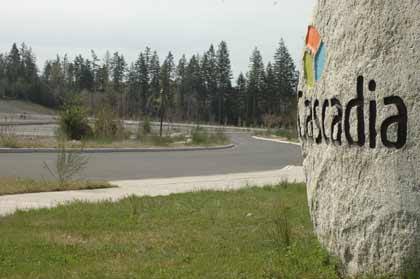By Brian Beckley and Dennis Box
The fate of the Cascadia development is now in the hands of a federal bankruptcy judge.
Located on 4,200 acres of land south of Bonney Lake, the Cascadia project is the largest Master Plan Development in the state, but after nearly two decades of planning and preparing, as well as the construction of roads, trails and an elementary school, the project – like the half-completed welcome center near the project’s entrance – is now in a state of limbo.
Like the rest of the building industry, the Cascadia project took a significant hit in the current recession and was unable to pay back more than $75 million in loans from Homestreet Bank.
Cascadia filed for Chapter 11 bankruptcy protection Oct. 11, 2009. On June 22, the trial began in front of Judge Karen A. Overstreet in the U.S. Bankruptcy court in Seattle.
According to the company’s reorganization plan, filed with the courts May 31, Cascadia will be purchased by TPG Opportunities Partners, YarrowBay Holdings and Obsidian Finance Group.
YarrowBay is presently seeking approval for what could be the state’s second-largest planned community, located outside Black Diamond.
The plan stated TPG would kick in $49.5 million for 90 percent ownership of Cascadia, YarrowBay $4.4 million for 8 percent and OPG $1.1 million for 2 percent ownership. The group is referred to as Holdings.
A second entity will also be formed titled Servicing Entity, which will manage the Cascadia project.
According to the letter of intent from TPG and included in the court documents, YarrowBay will be 60 percent owner of Servicing Entity and Obsidian 40 percent.
TPG, which was formally Texas Pacific Group, is described in the court document as “one of the largest private equity firms globally, focused on leveraged buyout, growth capital, and leveraged recapitalization investments in distressed companies and turnaround situations.”
Cascadia hired Obsidian in January as a financial advisor. The firm is described in the document as a “hybrid advisory and investment group.”
If the judge accepts the plan, YarrowBay could be part of building more than 13,000 residences between east Pierce County and Black Diamond.
Patrick Kuo, the founder and president of Cascadia, began the project 20 years ago. Kuo’s vision was an employment-based community, with high tech and light industry, a golf course and a 500-acre free trade zone with seven schools.
The first major problem hit Cascadia in 2006 when a tunnel being drilled under the Carbon River allowing connection to the Orting wastewater treatment plan collapsed, delaying the project.
The next major problem came in 2008 when three builders backed out of purchasing lots for homes. As the recession deepened Cascadia was unable to come up with the cash to meet debt obligations, the largest being the two from HomeStreet Bank totaling more than $75 million.
The bank began foreclosure proceedings on the loans in 2009.
“The bank wants to be paid the $76 million that it’s owed,” said lawyer Richard Stone in an April interview. Stone is an attorney with Ball Janik, the Portland, Ore.-based firm representing the bank.
Cascadia filed a petition for reorganization and recapitialization and the court gave Cascadia until May 31 to file a plan for reorganizing and paying debts.
The reorganization document stated if the plan is accepted by the judge, HomeStreet would receive a $10 million payment on the loan debt with a repayment plan for the balance.
Under the reorganization plan, Kuo would be out as the head of Cascadia, instead being paid $150,000 per year for three years. From that money he would pay the interest on a $1 million loan.
A decision on the bankruptcy is expected in July.


